
|   |

|   |
 e-mail: sunilkothari1933@gmail.com Nrutya Rangoli Samanvay Art Festival: Part 1 Photos courtesy: Samanvay May 11, 2019 It was a Bangalore Bonanza, the three day (19, 20 and 21 April) Nrutya Rangoli Samanvay Art Festival organized by that dynamic dancer, guru, choreographer, curator, and an able administrator Dr. Veena Murthy Vijay, held at Chowdaiah Auditorium. 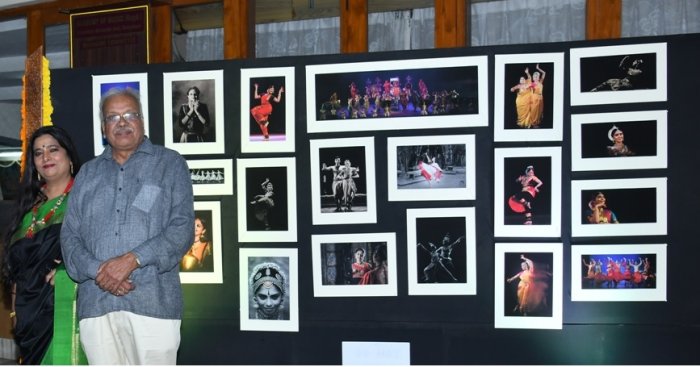 Photo exhibition On the inaugural day was an exhibition of dance photographs by four eminent photographers - Srivatsa Shandilya, Jayasimha Reddy, V.B. Suresh and Shiva Murthy. The renowned Kannada playwright and poet H.S. Venkatesh Murthy, Dr. C.N. Ashwath Narayan, MLA Malleshwaram constituency, Srinivas Srirangam, CEO of Jay Technology, who were the chief guests for the evening, declared the exhibition open. Held in the foyer of the Hall, there was enough space for display. A large crowd attended the opening. Some of the photographs were quite arresting and have captured the moods and movements of the dancers of variety of styles. The main event of the evening was a dance drama on Dhruva titled 'Star: The path to Brilliance' presented by Samanvay Dance Company headed by Veena Murthy Vijay. She has choreographed it on the concept given by Dr. Yellappa Reddy with script by Dr. H.S. Venkatesh Murthy. The music was by celebrated musician Praveen D Rao. The initiative was by Bangalore Environment Trust. Prior to presentation of the dance drama, Sangeetha Phaneesh, a disciple of Veena Murthy Vijay, presented Kuchipudi. Based on Ganesh tala, she executed the number with typical Kuchipudi movements highlighting the beauty of the form. Since it was in praise of Lord Vinayaka, his attributes in poetic Sanskrit like Girijaputra, Surapati, Bhujendra Gananatha, Modaka hastam (holding sweet ball in his hand), Nagavibhushanam (adorned with serpents as ornaments), using hastas and angikabhinaya to depict the iconography of the images of Ganapati, with his two waving ears, a trunk and his vehicle mouse, were etched well. Similar to Narayana Tirtha's Krishna Leela Tarangini, Veena Murthy had taught Sangeeta Phaneesh, Shiva Leela Tarangini. Performing it on rim of a brass plate with a small pitcher filled with water placed on head, she executed the footwork competently. She has a tall frame and long arms. Weaving various patterns she danced joyously winning rounds of applause for tarangam. Before dancing on the brass plate, she described Siva's form as Gangadhara, with crescent moon on his jata, Chandrachuda, lifted leg upwards to suggest urdhva tandava. She ended with refrain of Shiva Shiva Shiva and Om Namah Shivaya. Since the main dance-drama was sponsored by Bangalore Environment Trust, a documentary film was screened to show the various activities undertaken by the Trust for protection and preservation of environment. It was integrated later on with the story of Dhruva quite imaginatively. 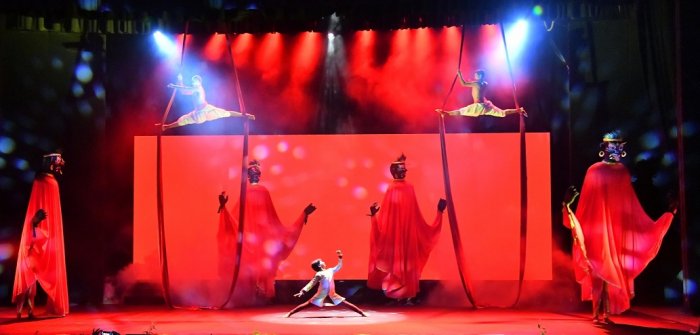  Dhruva Veena Murthy introduced the theme that ran on two 'timelines', one of the mythological and other of the present time, so one could grasp how the two aspects were combined alternatively. Dhruva's story is well known. The King Uttanpada has two wives Suruchi and Suniti. Suruchi's son sits on the lap of the king and when Dhruva, son of Suniti, asks his father to also sit on his lap, Suruchi does not allow and taunts him that he should have been born as a son to her. Thus discrimination becomes the main theme for parallel comparison. Dhruva is sent to forest to undertake penance. He learns a lot from nature, trees, water, rain, fish, deer, peacock, overcomes fear of demons, becomes strong and believes in removing discrimination since nature teaches him harmony, living with equanimity. The alternative scenes are brought in by realistic presentation. The backdrops of the school are shown. The young school children are playing in the grounds. A scene is shown of parents seeking admission to the school for their children. The authorities of school demand donations. There are on other side parents who cannot afford the donation for admission and their children are discriminated against others who get admission by paying donation. This discrimination is seen by a young student leader and he protests to the authorities who rebuke him and throw him out. He does not deter. He takes his allies with him to nature, forest, and he explains that nature does not discriminate. Again story moves to mythological timeline. Dhruva is confronted with devils. From the other side of the hall enter four larger than life, tall puppets dressed in red flowing costumes. They climb the stage with red light thrown on them. Little child Dhruva is surrounded by them, but he does not fear them and overcomes their attempt to frighten him. The suggestion is that like Dhruva overcomes the fear, the young children must overcome their fear. They must as Dhruva learn lessons from nature of harmony, like nature treat all equal and must not submit to discrimination. The use of graphics, backdrops to depict forest, waterfall, greenery, birds, sky, stars is handled well technically. From a galaxy of stars, Dhruva shines as a star. It is the path to brilliance. Then we are shown a quiz. The young student answers all questions correctly related to nature and wins the prize. The students dance together celebrating the message. The entire production runs smoothly with school children and Manu, the young dancer barely twelve, who is a disciple of Bharatanatyam teacher Radha Sridhar and has learnt Kathak from Hari and Chethana. He is well versed and is adept in many dance forms. His mother Rekha trains him. She has a large costume design shop and has designed costumes for the dance drama. At one level, the dance drama is like a school show, as it involves contemporary aspect of school children and a critique of the malpractice on part of school authorities. Veena Murthy has successfully incorporated elements of entertainment, including the tall puppets and the quiz. Since reality is indicated, the format of the dance drama looking like a school show does not jar. More than fifty young students participated; their parents must have attended the show to support the mega production. In all departments of lighting, coordination of movements from classical dance to modern natural movements, the music, the projection of graphics and backdrops, it evidently had popular appeal. And it carried the message that we need to protect our environment and avoid discrimination. 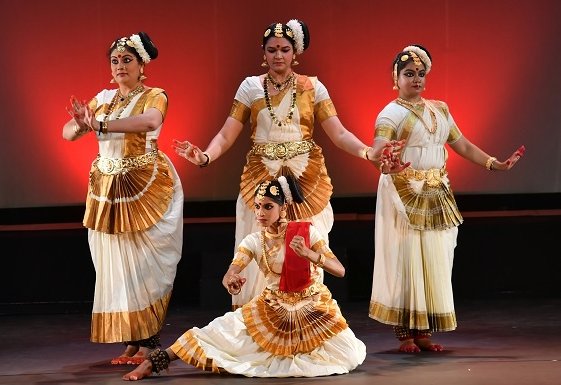 Mohiniattam by Monisha Arts Nrutya Rangoli festival had morning sessions on 20th and 21st April. On 20th April, Mohiniattam was presented by disciples of Guru Sridevi Unni under the banner of her institute Monisha Arts. The three young dancers dressed in typical Mohiniattam costumes and hair style with a bun on one side decorated with white flowers swayed slowly using the upper torso to the music. Chollkattu depicted the three rivers Ganga, Yamuna and Saraswati in Hamsanandi raga and adi tala. The other numbers included prayer to Krishna, the presiding deity of Guruvayur temple. One in raga Lavanya was in praise of Devi. It incorporated "Sarva mangala mangalye, shive sarvartha sadhike" stuti and evoked auspicious feelings. Sridevi Unni says she is planning to choreograph items based on Kannada poems which are full of devotion. It would be interesting to see how the cultural confluence takes places. Already the Odissi dancers settled in Bangalore are choreographing to Kannada bhakti poetry bringing in flavor of Kannada literature. Creative Lab is a brainwave of Veena Murthy and her disciple Shama Krishna. In their 3rd edition, they attempted topic of 'Nayika Vilas' - an analysis of choreographic works of young and upcoming dancers with focus on sringara on how they would portray the different nayikas. The concept was mentored by Kiran Subramanyam and coordinated by Shama Krishna. It was a praiseworthy attempt. It was not announced that they were choreographing on their own to the songs from Anthapurageete, the well-known Kannada literary poem by Gundappa. I was asked to be on panel discussion with Lalitha Srinivasan and Vidya Rao, who has been working on Sutradhara concept in dance dramas of South India and also of North India including Odisha and Assam.  Creative Lab-Nayika Vilas The six dancers had selected songs to depict the nayikas as swadhinapatika, virahotkanthita, kalahantarita, abhisarika, khandita and so on. After their presentation of the six nayikas, the three of us were asked to discuss their approach. Lalitha Srinivasan who is a scholar and an authority on Anthapurageete, aptly explained the content of the songs. Each nayika is in love with Chenna Keshava and in relation to him they had choreographed the abhinaya. Since there are sculptures of Madanika in the temple, Lalitha suggested that the dancers could have used sculpturesque poses for their exposition. I could suggest where certain emphasis would have brought the character more alive. Vidya Rao and Lalitha Srinivasan asked young dancers if they knew the characters proper reading the verses. They laid emphasis on what the poet also had in his mind when he wrote and it could be reflected. Unfortunately Kiran Subramanyam was away conducting workshop, therefore his concept was not explained, but I understood that the young dancers were encouraged to choreograph as per their understanding. Some more information was given that all the madanika sculptures are so carved that their eyes are directed to Lord Chenna Keshava only. The six dancers were Deepa Bhagwat, Y.G Srilatha, Pavitra Krishnamoorthy, Janaki Raghunath, Aditi Shreedhar, and Mayuri Kamath. Since majority of audience knows Kannada and are aware of the text and therefore the context, for non-Kannada persons, this session was quite educative. I liked the exercise and looked forward to similar session next morning on Nayaka Vilasa, where the male dancers were to depict the nayikas in different styles in which they were well versed. After the Nayika Vilas discussion, Sai Venkatesh gave an informative talk on lighting for dance performances with Surya Rao demonstrating. Why spotlight unless supported by other side lights will not light up the face. Dancers must now work out necessary budget for lighting. They must also rehearse with lights designer. Unless it is done, the lighting cannot be effective. He explained that all auditoriums are not equipped with all lights required. Therefore, if dancers do not visit in advance and make provision of lights in consultation with light designer, the expected result will not be realized. Sai gave examples of working with Vyjayantimala and Malavika Sarukkai. Today young dancers have become very savvy and plan well. Light plays an important role nowadays for dance performances. Sai is an experienced light designer with imagination and he always assists whenever approached. 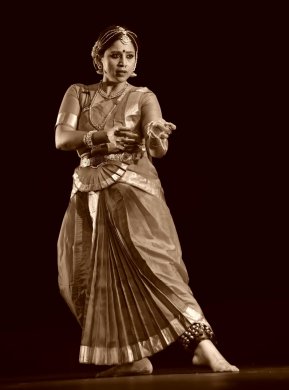 Deepthi Sudhindra The evening began with Bharatanatyam recital by Deepthi Sudhindra, a disciple of Veena Murthy. She has a background in theatre and delivering dialogues. She told me that she uses vachikabhinaya, using English language in order to communicate with larger audiences. She had selected Lalgudi's Charukeshi varnam on Krishna. In inclusion of Gita Govinda ashtapadi "Sakhi he keshi mathanamudaram," reminding Krishna of their first meeting and union, Radha asks Krishna how he could forget her and go away. Deepthi also included shloka which meant her complete surrender to Krishna: 'Kayen, vahchen, manasa samarpayami' - with my body, mind, speech, I surrender to you. Deepthi mentioned that she has been studying Natyasastra and in her journey of last ten years she has attempted to use other language poems also to enhance the expression or communication. Deepthi has in her presentation brought in feeling of surrender even when Krishna has left. But incorporating in varnam too many other compositions takes away from the impact of the varnam and its structure. It then looked like diluting the complaint Radha makes. Surrendering takes away from the agony of Radha. Deepthi could consider how to enhance that aspect. She needs to maintain sausthava, the erect body as her back curves while performing and concluding teermanams. Lighting by Surya Rao was as per the moods of other songs included. Nattuvangam was by Supriya, vocal by Vasudha Balakrishna, flute by Mahesh, and mridangam by Balakrishna. Dr. Tadepalli, the young traditional Kuchipudi exponent belonging to Kuchipudi village, who was recently conferred Bismillah Khan Yuva Puraskar by Sangeet Natak Akademi for Kuchipudi Yakshagana, was felicitated on this occasion by Raja Rajeswari Kala Niketan with Kalaposhaka Award for his contribution. He is a brilliant actor and his performance accompanying dancers in Bhama Kalapam has been hailed well. The evening belonged to dancers who interpreted 'Bhama' - her journey of love, separation and bliss with Lord Krishna, in Kuchipudi, Kathak and Mohiniattam. The concept of presenting story of Bhama in different dance styles was by Mohiniattam exponent Gopika Varma. It was an interesting exercise to see how the theme of Satyabhama is handled by artists of different styles. Shama Krishna trained by Veena Murthy presented patra pravesha daru in Kuchipudi. "Bhamane Satyabhamane" goes the refrain and Satyabhama enters covering her head with a colourful scarf. Revealing her beauty holding her jada, long plait, she described who she is, daughter of Satrajita and one having unparalleled beauty. Shama Krishna is endowed with physical charms and arresting stage presence. 'O lalana O chaliya' she enacts Satyabhama's sensuous grace with attractive abhinaya. She displayed the engaging arrogance of Satyabhama as a swadhinapatika nayika competently. She calls her confidante Madhavi, "Raave Madhavi, sarojanana," - O Madhavi, with face like a beautiful lotus, please go and call my beloved lord. Madhavi performed by Tadepalli indulges in usual repartee with Satyabhama to describe her beloved lord. They do not further elaborate this episode and end on a pleasant note. 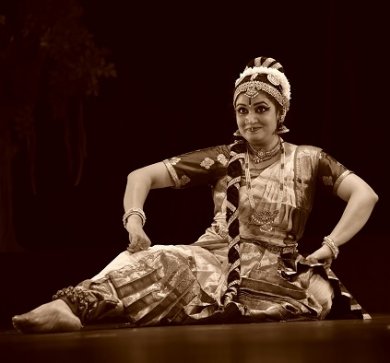 Shama Krishna 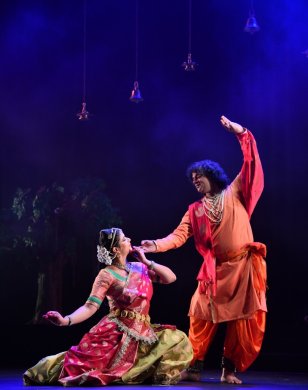 Vidha Lal & Abhimanyu Lal Vidha with her natural flair for nritta, taking excellent pirouettes, entered the stage, establishing at once the mood of Kathak and looked impressive as Satyabhama. Abhimanyu as Krishna appears on one side of upper level of stage when as Satyabhama, Vidha reminisces holding mangalasutra and the scene transforms into marriage rituals with Sanskrit shlokas and Veda mantras. Their joyous dance, being seated on swing was choreographed imaginatively. They performed tarana together in Hamir Kalyan ending the episode with beautiful pose. It was a successful interpretation in Kathak, perhaps for the first time. The music was composed by Geetanjali Lal, with costumes by Vidha Lal. The flute was by Rajat Prasanna, sarangi and music arrangement by Aslam Ali Khan, sitar by Salim Khan, tabla and pakhavaj by Amaan Ali, padhant by Vidha and Abhimanyu Lal. Gopika Varma in her exposition of Satyabhama Garva Bhangam choreographed how Satyabhama realizes that it is Lord Krishna who is supreme and not her entire wealth that she places on a balance to weigh Krishna in one side and putting everything she possesses on other side; the balance of Krishna remains heavier than her wealth. Prior to elaborating the theme, Satyabhama describes her own beauty, lineage, whose daughter she is and she has Krishna under her command. In typical Mohiniattam's alluring style, Gopika etched Satyabhama's character. Naradamuni enters playing mischief as usual. He confides in her that 'you may pride yourself as having command over Krishna, but he has given the heavenly Parijata flower to Rukmini ignoring you.' When Krishna arrives to meet her, she in anger does not talk with him, and Narada cleverly disappears. Krishna assures Satyabhama that he has merely given a flower to Rukmini, whereas for her he shall bring the Parijata tree from heaven and she must not doubt his love for her. Satyabhama arranges weighing of Krishna in a balance. And puts her entire wealth, ornaments, even her nose ring in the balance, but the side of Krishna's plate is heavy. Then Rukmini is asked to show how she would show Krishna's love for her. Rukmini places a mere tulsi patra and lo and behold, both the sides show equilibrium. Satyabhama realizes that no amount of wealth can measure the greatness of her lord. She begs pardon of Krishna for her false pride. Krishna forgives her and happily dances with both Satyabhama and Rukmini. Gopika has choreographed it with finesse and imagination etching each character of Satyabhama, Narada, Krishna and Rukmini clearly. In terms of abhinaya, music and presentation it was very well conceived and enacted by her. 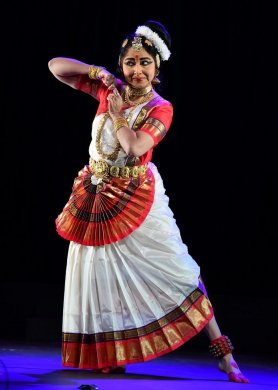 Gopika Varma 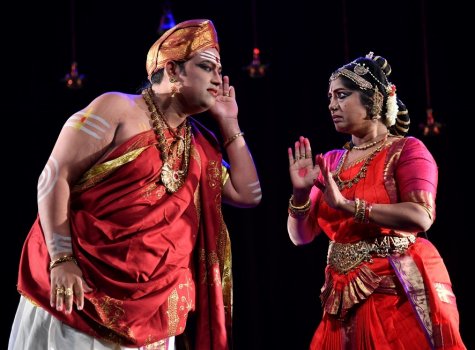 Tadepalli and Alekhya Punjala Alekhya Punjala from Hyderabad, currently Professor and Registrar of Telugu University, in her presentation of 'repenting' Satyabhama as 'Patralekha' in Kuchipudi along with Tadepalli as Madhavi, displayed exquisite abhinaya which was the highlight of the festival. The separation from Krishna has caused her immense grief. She begs of Madhavi to bring her lord back. Madhavi teases her and asks her to describe who her husband is. Satyabhama described nakhashikha paryanta, from head to toe with ornaments, of Krishna holding chakra, and Madhavi makes fun saying does she mean a potter. Then Satyabhama says he wears peacock feather, Madhavi asks is he a tribal. With his shankha, Madhavi teases further, is he Shiva Hara Hara Mahadeva? With Makarakundala, Madhavi asks is he a Brahmin? And so on. Their repartee done in traditional dialogue in Telugu does get communicated with gestures and one relishes it. Satyabhama asks how can she mention her husband's name in presence of such distinguished assembly and in public. Tadepalli weaves humour about the excuse and Satyabhama then reveals that her lord is Krishna. She also says that when he came to see her in her palace, she was looking in a mirror. Krishna asks her between her and him, who is more beautiful. In arrogance Satyabhama responds that of course she is more beautiful at which Krishna took offence and repaired to his palace. Satyabhama realized her mistake that it is her own husband, who is supreme and how come she made such a mistake? Finally Madhavi agrees to go and meet Krishna on condition that unless Satyabhama gives him the nose ring, she will not go. Satyabhama unwillingly offers it, which with humour Madhavi (Tadepalli) examines if it is of real gem. She asks Satyabhama to dictate a letter to her. Satyabhama sings "Srimad ratnakarputrika," one of the finest poetries in Telugu language, the best love letter ever written, and describes the beauty of her bed Hamsatulika, which is studded with gems, rubies, diamonds, Krishna was with her and she committed mistake of declaring herself more beautiful than Krishna. He left her, and she is in great agony, begs him to forgive her as she offers sashtanga danadavata pranam, falling on floor prostrating before him. Satyabhama quickly reads and signs the letter, telling Madhavi to go quickly because there are good omens. The milkmaids are on their way, and Brahmins are also going to temple. "Shakunale manchi vare" is rendered and Madhavi takes leave, Satyabhama looking with anxiety. The performance ends there. The abhinaya by Alekhya was moving and one marveled at how she identified with the agony of Satyabhama. Her entire being displayed those emotions. I shall remember this particular performance for a long time. Her natural beauty and grasp over the text and the feeling of virahotkanthita nayika were palpable. Tadepalli also rose to his usual humorous heights as Madhavi. The music, the aharya, the vachikabhinaya and the entire presentation left an indelible impression. Those who watched it were lucky and those who did not, indeed missed an excellent performance. Nrutya Rangoli Samanvay Art Festival: Part 2  Dr. Sunil Kothari is a dance historian, scholar, author and critic, Padma Shri awardee and fellow, Sangeet Natak Akademi. Dance Critics' Association, New York, has honoured him with Lifetime Achievement award. Post your comments Please provide your name and email id when you use the Anonymous profile in the blog to post a comment. All appropriate comments posted with name & email id in the blog will also be featured in the site. |